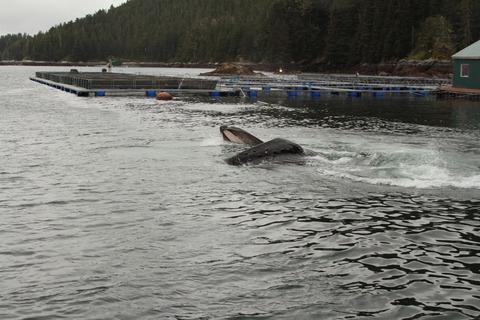当前位置:
X-MOL 学术
›
Funct. Ecol.
›
论文详情
Our official English website, www.x-mol.net, welcomes your
feedback! (Note: you will need to create a separate account there.)
Confronting assumptions about prey selection by lunge-feeding whales using a process-based model
Functional Ecology ( IF 4.6 ) Pub Date : 2021-06-05 , DOI: 10.1111/1365-2435.13852 E.M. Chenoweth 1, 2 , K.M. Boswell 3 , A.S. Friedlaender 4, 5 , M.V. McPhee 1 , J.A. Burrows 6, 7 , R.A. Heintz 8 , J.M. Straley 2
中文翻译:

使用基于过程的模型对抗弓步喂养鲸鱼的猎物选择假设
更新日期:2021-08-09
Functional Ecology ( IF 4.6 ) Pub Date : 2021-06-05 , DOI: 10.1111/1365-2435.13852 E.M. Chenoweth 1, 2 , K.M. Boswell 3 , A.S. Friedlaender 4, 5 , M.V. McPhee 1 , J.A. Burrows 6, 7 , R.A. Heintz 8 , J.M. Straley 2
Affiliation

|
- The relative energetic benefits of foraging on one type of prey rather than another are not easily measured, particularly for large free-ranging predators. Nonetheless, assumptions about preferred and alternative prey are frequently made when predicting how a predator may impact its environment, adapt to environmental change or interact with human activities.
- We developed and implemented a process-based model to investigate the potential energetic benefit (PEB) of in situ foraging opportunities in rorqual whales. The model integrates and evaluates the energetic importance of measured prey patch characteristics (prey distribution, energy content and predator avoidance) and predator characteristics (morphometrics, foraging tactics and feeding rates). We applied the model to test the assumption that hatchery-released juvenile salmon are an ‘easy meal’ for humpback whales compared to more common prey: herring and krill.
- In 11 out of the 13 foraging situations considered, whales were found to be feeding in a manner where net energy gain was greater than the energetic costs of non-foraging swimming. Humpback whale PEB for hatchery-released juvenile salmon fell within the range of the PEB for krill and herring but varied by species, from relatively high PEB for chum salmon to relatively low for coho salmon. Our model provides behavioural insight as well, indicating that shallow feeding may be more important for reducing energy expenditure through slower lunge speeds than for increasing prey capture. The model also provides a means of identifying prey patch characteristics, with prey aggregation playing the largest role in determining PEB despite being a poor overall proxy for PEB, supporting the use of the complex model framework.
- Modelling approaches are especially valuable where they can use reasonable assumptions to substitute for lack of reliable observations, thereby integrating a range of interacting factors into a single framework. Additionally, because process-based models can be used to make predictions outside the range of previously observed conditions, they will be increasingly useful in a changing climate.
中文翻译:

使用基于过程的模型对抗弓步喂养鲸鱼的猎物选择假设
- 以一种猎物而不是另一种猎物觅食的相对能量收益不容易衡量,特别是对于大型自由放养的捕食者。尽管如此,在预测捕食者如何影响其环境、适应环境变化或与人类活动相互作用时,经常会做出关于首选和替代猎物的假设。
- 我们开发并实施了一个基于过程的模型,以研究 rorqual 鲸原位觅食机会的潜在能量效益 (PEB)。该模型整合并评估了测量的猎物特征(猎物分布、能量含量和捕食者回避)和捕食者特征(形态测量学、觅食策略和摄食率)的能量重要性。我们应用该模型来测试以下假设:与更常见的猎物:鲱鱼和磷虾相比,孵化场释放的幼鲑鱼是座头鲸的“轻松食物”。
- 在所考虑的 13 种觅食情况中,有 11 种发现鲸鱼以一种净能量增益大于非觅食游泳的能量成本的方式进食。孵化场释放的幼鲑的座头鲸 PEB 属于磷虾和鲱鱼的 PEB 范围,但因物种而异,从相对较高的鲑鱼 PEB 到相对较低的银鲑鱼。我们的模型也提供了行为洞察力,表明与增加猎物捕获相比,浅层喂食对于通过较慢的弓步速度减少能量消耗可能更重要。该模型还提供了一种识别猎物补丁特征的方法,尽管猎物聚集对 PEB 的整体代理效果不佳,但在确定 PEB 方面发挥了最大的作用,支持使用复杂模型框架。
- 建模方法特别有价值,因为它们可以使用合理的假设来替代缺乏可靠的观察结果,从而将一系列相互作用的因素整合到一个单一的框架中。此外,由于基于过程的模型可用于在先前观察到的条件范围之外进行预测,因此它们在不断变化的气候中将越来越有用。











































 京公网安备 11010802027423号
京公网安备 11010802027423号